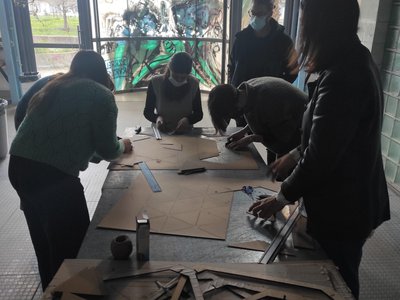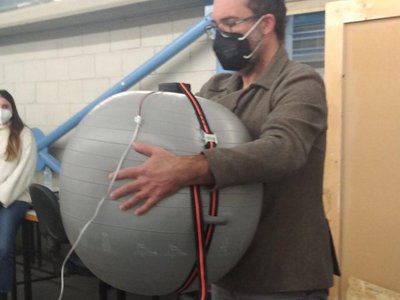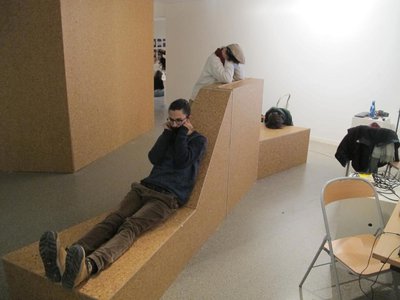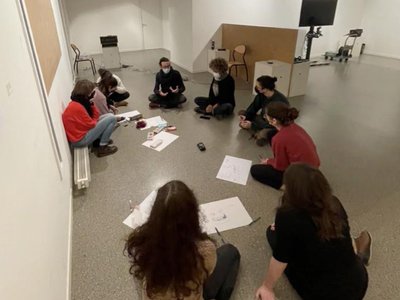Listening to the world can be seen today as a posture of scaling facing the usual frames of reference and allows us to pay more attention to vulnerabilities: how does the world sound to our ears? How does it sound when we are children? How does it sound when our bodies suffer and age? How does it sound when our senses or our beings are "different"? To answer these questions, in 2021 we explored the theme of the vulnerability of listening and showed that it can be broken down into three interdependent dimensions: environmental, social and spatial vulnerabilities.
The 2022 edition proposed to the participants to think more precisely about the cultural and spatial dimensions of the perception of ambiences by working on "sound spaces in waiting": architects, urban planners, artists, designers, but also inhabitants, we conceive and occupy the public spaces of our cities and the landscaped space is often the place of various sound practices: words, musical listening, sports practices, walking, stay, meetings, etc. How can we design public space and its furniture to be less vulnerable? How can a public bench become a waiting sound space, ready to be activated by an individual (a hearing impaired person, a group, a child, etc.)? How can these urban objects be designed and constructed to provide multiple, sensitive and multicultural listening experiences? What kind of « sound spaces in waiting » can be designed and built to give or bring attention to the vulnerabilities and pluralities of uses and spaces?
- Arts to Science Sound spaces in waiting (Nicolas REMY/ Théo MARCHAL)
General introduction to the theme "sound spaces in waiting" - Urban transports as sonic infrastructures of feeling: hearing, mapping, understanding (Damien MASSON)
The daily experiences of urban transports bring into play tactile, body-to-body, breathing, sweating, sound, etc. More than visual and embodied, these pathic experiences invite us to propose renewed geographies of urban mobilities. This intervention proposes a theoretical and methodological reflection on an ordinary aesthetics of transport infrastructures which are considered as infrastructures of feeling. In doing so, we aim to comprehend their active role in the formation of sensitive experiences and affective atmospheres of ordinary mobilities. To do so, this paper will use two research projects which aim at understanding collective emotions and embodied power relationship in Paris’ train and metro infrastructures. Firstly, the mobile and sensory methods that have been used to grasp the emotional, embodied, ethereal etc. at play will be presented. Secondly, we’ll develop a mapping attempt of some of the researched situations, which proposes to substitute time for space in order to highlight the importance of the temporal dimension in the expression of the lived situations. Lastly, we will propose an open reflection on the possibilities visual translation of more-than-representational phenomena its stakes and limitations. - Micro-radio : formes et sociabilités des ondes radio (Julien CLAUSS)
The oldest of the new media, radio has introduced an infused use of electromagnetic fields into society. From TSF to DAB via FM, the invisible nature of radio waves has given this medium a unique aura. From installations exploring the physicality of radio waves to participatory micro-radio devices, Julien Clauss will present a panorama of artistic projects that visually summon radio. - Cartophonies (Sylvie LAROCHE)
In parallel to quantitative acoustic maps, a diversity of cartographic representations of the sound environment is developing. Among these, I will present the second version of the « cartophonies » tool (interface developed by the Cresson laboratory). From these examples, which present a better sharing of sound ambiences in time and space, I will explore the remarkable sound dimensions of a place. - Virtual Echo, Propagation and Absorbsion Frontiers’s fluidity and Dynamic Heterotopia (Annie LUCIANI / Giuseppe GAVAZZA)
In this presentation, we examine the conjunction between (1) the mythologic concepts of auditory echo and reflection, (2) their extension to visible phenomenon, (3) a new digital technology and a new interactive art. We introduce a new concept, called “interactive simulated matter” allowing to render wide variety of echoes, reflections or more or less permanent absorbing effects in response of actions. Such simulated phenomena enlarge the realistic ones – acoustical echo or optical mirroring – by creating intermediate situations of propagation, echoes and permanent or ephemeral absorptions and engraving. The concept of interactive and dynamic simulated matter illustrates the concept of heterotopia with an intimate intertwining of space and time. Further, it explores, in visual arts, the notion of the frontiers, from clearly-cut limit to total evanescence, not only in terms of space but also in terms of time. Fundamentally speaking, such questions address the question of the fluidity of the frontiers, not only in terms of space but also in terms of time. It is why we can speak here on “dynamic heterotopia” as a temporal point of view of the concept of heterotopia developed by the French philosopher Michel Foucault in social spaces. - The Soundscape of War (Lejla Odobasic Novo)
The sound of an urban space is both performed by people as well as shaped by the natural and man-made aspects of the urban environment. Architectural planning seeks to create an acoustic equilibrium, taking into account the city’s natural geography. This is also the case for Sarajevo, a city that sits in a valley, with a carefully constructed acoustical equilibrium in its conception. During the four-year siege this acoustical equilibrium was unquestionably upturned. Through this research we examine the soundscape of war as experiences by fifteen witnesses that survived the siege of Sarajevo. We look at the acoustic implications on urban space and collective memory both during and after the war. - Sound, space and fieldwork : Materiality and Audibility – working with Deaf adolescents and sound (Dana PAPACHRISTOU/ Yorgos SAMANTAS)
In the framework of B-Air, TWIXTlab has been working with artists and with Deaf and hard-of-hearing children and their educators in their school setting, exploring alternative experiences with sound through artistic practice. In the presentation, we will reflect on our experience from the field, our methodology of approaching the classroom, and our future actions. Further, we will explore materiality as a valuable aid for alternative ways of listening and engaging the children with the sonic universe, as well as the spatial aspects of the educational/artistic process. - Listening Pieces/Rooms (Grégoire CHELKOFF)
For several years we have experimented spatial devices at the scale of the moving body in different situations to create sound pieces / rooms. Designed through spatial notions as articulations, limits and inclusion, these devices can respond to certain issues in daily life, habitat or public space. The objective is to create spaces and situations through the sound experience sought, often on a small scale according to weak or not very important wall proximities and according to simple gestures of use. Once completed, the « listening pieces / rooms » will also solicit the other senses associated with the spatial experience: movement, tactility, luminosity, scents in order to question the sensory interactions and ambient qualities evoked or perceived in the installations produced. A brief overview of these experiences will show some examples, the categories and the method used. - Losonnante: a bone conduction listening device (Sebastien DEPERTAT/ ThomasBONNENFANT)
Losonnante is a bone conduction sound device that attempts to renew the approach to sound and listening in their relationship to living environments. Based on a micro digital audio system, the listening requires to rest the elbows on the device while resting the hands on ears. Thus, it offers an immersive experience that work on questions such as form, aesthetic, listening position, attention and sound content. This presentation will be a general introduction to this device and will question the way it could open up other ways of listening and being attentive to our living environment. In particular, we will speak about the listening of Knud Viktor’s oeuvre through this device. Knud Viktor was a Danish artist, a « sound painter » who spent a large part of his life composing from the micro-sounds from his environment.
B-AIR Lectures
- A journey through soundscapes heard by special ears: Soundwalk, soundscapes and composition (Sylvia CUCCHI / Giorgia AMICO)
People with special needs actively explore and make sense of their environment in a personal way. We need an approach to music and sound education that appeals to people with special needs to support making sense of everyday life. We present and discuss a individualized music education project with a woman with special needs experienced through soundwalks with the creation of a personal soundscape. The goal of the experience is to explore a mode of listening in which educators and special learners live and play out their own cultural experiences through sounds that coexist and interact. Unconventional notation in the setting represents a potential space where listening becomes shared creation and composition, starting form individual coding and decoding to produce and document new or imaginative collective responses. Music education is often based on motor synchronization activities with an emphasis on sharing rhythm and time, but researchers have often found differences in individuals with disabilities ( e.g Autism Spectrum Disorders -ASD and Attention Deficit Hyperactivity Disorder – ADHD) in the body-environment relationship through the sense of time, with the result that these individuals may experience loneliness in the music lesson. Creative activities based on soundscape listening could facilitate the development of sound-based relationships, resulting in collective representation and potentially reducing any negative experiences in sharing musical activities. Interactive Soundwalks and landscape perception through shared listening, by emphasizing the close relationship between music, culture, and identity, promote shared decision making, participatory bonding, and interaction with the environment and offer a fertile context for redefining the role of music education in the curriculum. - B-Air online radio Platform (Gregor Pirš, Jan Jona Javoršek)
The authors present here the last update (conceptual and technical) for the online tool that will be available for sound creation in the next months : the B-AIR online radio platform or on line tool for infinite radio composition and creation.
Workshops in Volos and Grenoble
The participants were invited to explore the production of devices on a body scale, using listening to question this issue. It was chosen to work on the sound spaces for and in waiting to echo three “categories” of sound vulnerability: social, spatial and environmental vulnerability. The workshop work took place from Tuesday to Friday and was organized in parallel on the two host sites of the winter school: – the National School of Architecture of Grenoble in France, – the Department of Architecture at the University of Thessaly in Greece. The working time in French and Greek on each site was punctuated by exchanges and remote presentations via ZOOM meetings in English. The two workshops led to a moment of presentation and friendly exchange in hybrid between France, Greece and the remote participants to share and exchange on the participants’ productions.
VOLOS
Supervision team: Dimitris Psychogyios, Petros Flampouris, Dana Papachristou, Yorgos Samantas, Ioannis Manis and Nicolas Rémy.
Participants: Ioanna Tirogianni, Christina Diamantopoulou, Evanthia Soumelidoy, Kyriaki Gaitanidou,Dimitra Koutsaka, Lina Grigoraki, Ifigenia Karameliou, Athanasios Karakostas, Giorgos Chatziefthimiou, Sotiria Grafakou, Maria Galani, Dorothea Pavlidou, Vassiliki Anastasiou
Theme: The aim of the workshop was to design and build a piece of street furniture, on a one-to-one scale, that is accessible to all users and capable of producing a sound and/or vibration and synchronous transmitting an emotion. Volos workshop team consisted of 12 participants and several tutors. The participants were asked to develop and form a one-to-one scale structure at the end of the week. The workshop methodology was grounded with several theories and approaches that were introduced during the first two workshop days. The workshop learning structure was linear following the milestones “impact form presentation-testing-brainstorming-creative design-model making”. The impact from the presentation, helped the participants, on a technical, theoretical and referencing level. Creative design and idea investigation methodologies were inspired by the “Articulation-Limit-Inclusion” (Chelkoff,2003) design approach. During the testing phase, semi-empirical methods of sound evaluation and simplifications of sound concepts, in order to communicate them to the participants, were used, along with hands-on experimentations. Simultaneously, different materials, tools, speakers, amplifiers, were mobilized in order for scale models to experiment and be produced. Different design conditions were tested by the participants, morphological and material wise. Further, during the brainstorming phase, taking into account the inclusion and exclusion matters in the design development process, early design ideas were formed by the use of physical sketching, 2D and 3D-modeling software along with scale models. Automation and prototyping tools were encouraged for the development of the sketch models (prototypes). During the early stages of the design process cad/cam technologies, laser cutting machines ( EPILOG LASER 9000 LEGEND 36EXT) and 3Dprinter were adopted. The designs were altered accordingly during the developing and experimentation process. Thus, several models and ideas were produced in order for the participation team to accord and develop a final model that could be constructed in physical scale by the participants/designers themselves.
GRENOBLE
Supervision team: Théo Marchal, Sebastien Depertat, Laureen Gomez, juL McOisans, Cédric Pichat, Nicolas Tixier, David Argoud
Following a series of lectures on the issues associated with waiting spaces, vulnerability, but also the modalities of diffusion and propagation of sound in space, the participants began to think about listening, waiting or wandering devices at the body scale. The working method consisted of an intensive 3-day period of reflection, design, sketching and fabrication of spatial devices as well as of diffused sound pieces. The first day allowed them to discover the context of work : a large empty room, very reverberant which will welcome the proposals of the participants. Then, they were able to test the different modalities of sound in space (frequencies, intensities, directivities, solid state or aerial diffusion) with different diffusion and captation tools. The participants had at their disposal construction materials (wooden plates and organic wool) as well as tools for sound capture (recorders, microphones), sound editing/transformation/generation (synthesizer, computers, software) and finally sound diffusion (loudspeaker, solid state transducers in mono/stereo and multi-channel).
At the end of this first experiment of sound in space, a time of collective exchange allowed us to think about two devices of acoustic and sounding spaces : a “listening bench” and a “sound chicanery”.
A listening bench: The first device built is the result of a reflection on the solidian diffusion of the sound for a waiting space such as a bench (public or private) and the various postures of body which can be associated with it. It combines a direct transducer diffusion (in a lying position, between the two shoulder blades), and two indirect diffusion : through the bones first (via a vertical rigid core on which the elbows are placed in a standing/armed position), and through a vibrating seat that vibrates both the air and the body by means of the rigid wooden membrane to which the transducers are attached.
Wrapping, distance and absorption: The second device was thought as a coil which allows to extract itself at different proportions from the surrounding sound environment. It was a matter here of proposing at the same time a space which constrains the body and the sounds so as to generate a gradation in the isolation and the absorption (more and more acoustically matt) but also in the number of bodies being able to move forward in the device and their position, having to be increasingly curled up in order to to move forward until the last point. By exploiting the materials at disposal (heavy wood panels (LivingBoard 15mm) and natural insulation (BiofipTrio), as well as the context of installation of the device (an empty room with a large reverberation), the participants were able to propose a strong contrast effect between two points ; inside and outside the device. The most interesting result was also a progressive effect, and the possibility of adjustment of the acoustic and haptic effects on the body in movement and on the potential uses of such a device referring to the protection and to the sound, visual and kinetic intimacy.
Sound message and love letters: A third group of participants proposed to explore the city of Grenoble and to deposit “like a bottle in the sea”, letters of “love” in order to collect in response testimonies by text message or vocal message on a “burner phone”. These answers were then translated into midi messages, then into sounds diffused in headphones. This proposal puts in tension the intimacy of a private exchange, on the scale of a mailbox or a street, and a cartographic and urban dissemination in the sum of the listening and the postcards thus presented.
Conclusion
The workshop’s success in Grenoble lies in the participants’ quick ability to take hold of both sound and physical matter to produce spatial-sound devices and test hypotheses relating to the issues of vulnerability, sound and waiting spaces. Thus the listening bench and the visual and sound isolate function together in the room, but above all they propose two radically different experiences and therefore adapted to different situations of use. The bench has allowed prototyping different ways of listening through the matter, whether it is for a noisy environment, for people with disabilities, or for a different listening research to “call” the user’s ear. These listening modalities are coupled with body postures that decline typology and temporalities of waiting (sitting, standing, lying down) to test and propose new ways of listening. The isolate which wraps around itself offers, by its dimensioning and its materialities, the possibility of regulating a form of haptic intimacy, whether it is a question of virtually taking distance while remaining in the same room, or of extracting oneself completely from a situation, one observes here a proposal which could be declined at various scales while preserving its properties of protection/projection. These proposals echo the reflections already carried out during the winter school of 2021 (entirely online) and which had not been able to test concrete devices of setting in form / space of these questions.
General Chair : Théo Marchal & Sébastien Depertat (Grenoble) Nicolas Rémy, Evangelia Paxinou and Dimitris Psychogios (Volos)
with Françoise Acquier, Giorgia Amico, David Argoud, Grégoire Chelkoff, Julien Clauss, Sylvia Cucchi, Giuseppe Gavazza, Laureen Gomez, Sylvie Laroche, Annie Luciani, Damien Masson, juL McOisans, Lejla Odobašić Novo, Dana Papachristou, Cédric Pichat, Georges Samantas, Jean Paul Thibaud, Nicolas Tixier, TWIXTlab




